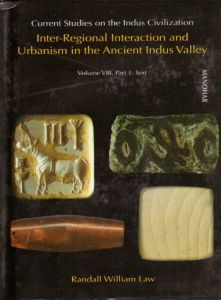
Contents: Part I: Text and Part 2: Appendices and References: Foreword. Preface. 1. Objective overview and theory Harappa and lines of inquiry. 2. Harappa in context. 3. Strategies and methods for sourcing stone and metal artifacts. 4. The rock and mineral artifact assemblage at Harappa. 5. Grindingstone acquisition networks. 6. Chert acquisition networks. 7. Steatite acquisitions networks. 8. Agate acquisition net works. 9. Vesuvianite grossular acquisition net works. 10. Alabaster acquisition networks. 11. Limestone acquisitions networks. 12. Lead silver and copper acquisition networks. 13. Summary and discussion. 14. Concluding remarks. Appendices. References.
This is the first part of the eighth volume of Current Studies on the Indus Civilization. It is an examination of interregional interaction and urbanism in the Greater Indus region of Pakistan and north-western India during the period that encompassed the development, existence and decline of South Asia's first urbanized society. The principal research objective is to identify the geologic sources from which the stone and metal artifacts excavated at Harappa - a site that grew from a small village to become one of the largest Indus Civilization cities, were most likely derived. Using techniques ranging from studies of basic macroscopic and mineralogical attributes to highly precise and accurate isotopic and elemental assays, grinding stone, chert, steatite, agate, vesuvianite grossular, alabaster, limestone and various metal artefacts are directly compared to geologic samples of those materials collected from sources across South Asia.
Geologic provenience to determinations, periodized with reference to Harappa's detailed chronological sequences are used to inform three lines of inquiry. The first two concern identifying the Harappans inter-regional relationships, defining their extent and tracking them through time. The third involves elucidating synchronic variations in those relationships at the local or site level.
This is the second part of the eighth volume of Current Studies on the Indus Civilization contains appendices and references. In it are the raw data used to generate over 2100 geologic provenience determinations for stone and metal artefacts from Harappa as well as almost 120 determinations for artefacts from a number of other Indus Civilization or related sites. Also contained herein are new observations and analyses of unique artefacts and specialized technologies, experimental studies involving both geologic samples and archaeological materials, and focused examinations of specific issues related to the use and acquisition of rocks and minerals in ancient South Asia. (jacket)
